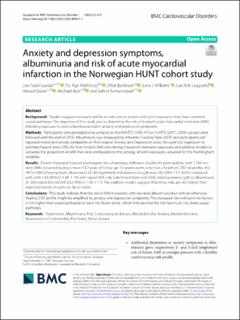| dc.contributor.author | Gustad, Lise Tuset | |
| dc.contributor.author | Myklebust, Tor Åge | |
| dc.contributor.author | Bjerkeset, Ottar | |
| dc.contributor.author | Williams, Lana J | |
| dc.contributor.author | Laugsand, Lars Erik | |
| dc.contributor.author | Dalen, Håvard | |
| dc.contributor.author | Berk, Michael | |
| dc.contributor.author | Romundstad, Solfrid | |
| dc.date.accessioned | 2022-11-23T10:31:38Z | |
| dc.date.available | 2022-11-23T10:31:38Z | |
| dc.date.created | 2022-11-10T20:29:28Z | |
| dc.date.issued | 2022 | |
| dc.identifier.citation | BMC Cardiovascular Disorders. 2022, 22, . | en_US |
| dc.identifier.issn | 1471-2261 | |
| dc.identifier.uri | https://hdl.handle.net/11250/3033600 | |
| dc.description.abstract | Background
Studies suggest increased risk for an outcome in people with joint exposures that share common causal pathways. The objective of this study was to determine the risk of incident acute myocardial infarction (AMI) following exposure to both albuminuria and/or anxiety and depression symptoms.
Methods
Participants who provided urine samples to the HUNT2 (1995–97) or HUNT3 (2007–2009) surveys were followed until the end of 2016. Albuminuria was measured by Albumin Creatine Ratio (ACR) and participants self-reported mood and anxiety symptoms on the Hospital Anxiety and Depression scale. We used Cox regression to estimate hazard ratios (HRs) for first incident AMI considering interaction between exposures and additive models to calculate the proportion of AMI that were attributable to the synergy of both exposures, adjusted for the Framingham variables.
Results
Eleven thousand fourteen participants free of previous AMI were eligible for participation, with 1234 incident AMIs occurred during a mean 13.7 years of follow-up. For participants who had a healthier CVD risk profile, the HR for AMI of having both albuminuria (3–30 mg/mmol) and depression (≥8) was 2.62 (95% 1.12–6.05) compared with a HR 1.34 (95% CI 1.04–1.74) with raised ACR only (Likelihood Ratio-test 0.03). Adding anxiety (≥8) to albuminuria (3–30) tripled the risk (HR 3.32 95% CI 1.43–7.17). The additive models suggest that these risks are not higher than expected based on each risk factor alone.
Conclusions
This study indicate that the risk of AMI in persons with elevated albuminuria but with an otherwise healthy CVD profile might be amplified by anxiety and depression symptoms. The increased risk with joint risk factors is not higher than expected based on each risk factor alone, which indicate that the risk factors do not share causal pathways. | en_US |
| dc.language.iso | eng | en_US |
| dc.publisher | BioMed Central | en_US |
| dc.rights | Attribution-NonCommercial-NoDerivatives 4.0 Internasjonal | * |
| dc.rights.uri | http://creativecommons.org/licenses/by-nc-nd/4.0/deed.no | * |
| dc.title | Anxiety and depression symptoms, albuminuria and risk of acute myocardial infarction in the Norwegian HUNT cohort study | en_US |
| dc.title.alternative | Anxiety and depression symptoms, albuminuria and risk of acute myocardial infarction in the Norwegian HUNT cohort study | en_US |
| dc.type | Peer reviewed | en_US |
| dc.type | Journal article | en_US |
| dc.description.version | publishedVersion | en_US |
| dc.source.volume | 22 | en_US |
| dc.source.journal | BMC Cardiovascular Disorders | en_US |
| dc.identifier.doi | 10.1186/s12872-022-02921-1 | |
| dc.identifier.cristin | 2072105 | |
| dc.source.articlenumber | 472 | en_US |
| cristin.ispublished | true | |
| cristin.fulltext | original | |
| cristin.qualitycode | 1 | |

